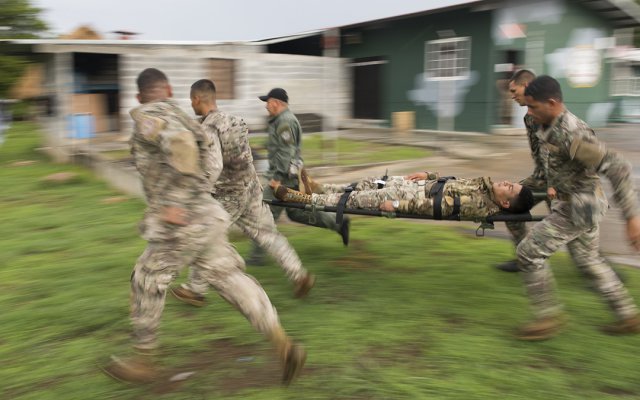“Fuego! Fuego! Fuego!” Sgt. 1st Class Russell Planer shouts through a bullhorn, and four-person teams of Panamanian security forces dash off with their stretchers to locate their “injured” compadre.
The teams are participating in an exercise. It’s part of the medical training that Planer runs to improve the agents’ response times and steel them for shootouts with narcotics traffickers.

The country has no military, but the combined security forces of Panama’s Ministry of Public Safety that protect the nation from illegal activity at its borders, seaports and famous canal can face armed conflicts with cartel members that are reminiscent of a war zone. And one of the missions of the U.S. Army’s Technical Assistance Field Team in Panama is to help keep them safe.
“They take fire when a casualty is down, and they have to remove the casualty from under fire to a semi-safe location,” Planer said, describing the exercise at a training site in Panama City, Panama.
“Then they have to do a very quick evaluation of the patient. If there’s major hemorrhage, they put a tourniquet on that extremity and control that major hemorrhage. Then they do a quick sweep over the casualty, to make sure that they haven’t missed anything. At that time, they’re prepared to put them on a litter and remove them from the fire zone.”

They carry the patient about a kilometer away to a more secure location and then begin tactical field care. They check over all the major organ systems and examine eyes, ears, nose and mouth. They conduct tests on the patient’s pulse and motor systems. They inspect the body for fractures or any other sort of injury, including at the spine and back.
They treat the patient as they go and reevaluate regularly to ensure treatments are working, Planer said. After determining vital sign statistics and mechanism of injury, the team can assess bleeding, and the medics will know whether to administer fluids and how much.
The teams consist of agents who play the roles of medic, assistant medic, security and litter carrier. A fifth member plays the patient. Planer runs the exercise multiple times, so each officer has the chance to fill each role. Each must place tourniquets, remove patients, control the team and administer fluids intravenously.

Blood runs down several of the arms of the patients as Planer and an assistant, who was tapped from Panamanian security forces to help after a previous iteration of the course, walk from team to team, evaluating the medics’ performance.
“That IV is actually [taught] much later [in the course], but we’re doing the IV now for the stress level and practice because they have to do an IV to finish the course,” he said.
The final event requires the medics to complete treatment in 25 minutes.
“I push them under the fire stage to be under three minutes,” Planer said. “They have a maximum of six minutes, but remember, it’s 25 minutes, so if they use six minutes there, they only have 19 minutes for full treatments, which is putting on splints, treating wounds, intubation and so on and so forth.
“This [event] plays into the lanes because it gives them a very little taste of what they’re going to have to do for the full event at the end,” he continued. “This is just the very first portion.”
Yadiza Perez, the agent who helps teach the course, is one of Planer’s students from earlier classes. “She was one of the star students, so to speak,” Planer said. “She was very good, very motivated. She was helping her compadres, her partners.”

Using star pupils to assist with later courses fits into the overall strategy of the Technical Assistance Field Team to develop a train-the-trainer strategy when assisting allied nations. It also allows Planer increase the student capacity of the course, he said.
TAFTs are deployed by the U.S. Army Security Assistance Training Management Organization, a subordinate organization to USASAC. USASATMO currently has 38 TAFTSs and 43 teams in more than 20 countries around the world.
Planer played a critical role in developing the program of instruction for the medical course, said Maj. Bernard Gardner, who leads the TAFT in Panama.
“There’s a lot of trust involved,” he said. “There’s a lot of communication that the NCOs have to do to make sure we’re meeting the right capability that the Panamanians are requesting. And then in doing that, they identify that capability and they develop POIs.”
All the NCOs in the TAFT team must be fluent Spanish speakers, but they also must write in Spanish well. Planer developed the written version of the POI in English and Spanish, in addition to teaching complex medical terms and concepts in Spanish.
“Another thing that people don’t realize is the written communication skills that these guys bring to the table,” Gardner said. “Everything that we do here, we have a written correspondence, basically it’s the equivalent of Army memorandums.
“There is official correspondence to the Ministry of Defense that we push all this training through to answer their needs and to ensure that everyone has a visibility and it’s meeting the intent and the capability they requested.”
“There’s a good two weeks where (Planer was) just sitting down developing the POI in excruciating detail so it communicates the right intent,” Gardner said.
And as any member of Panama’s security forces knows, Planer’s intent is to keep them safe under fire.
By Clifford Kyle Jones, NCO Journal
